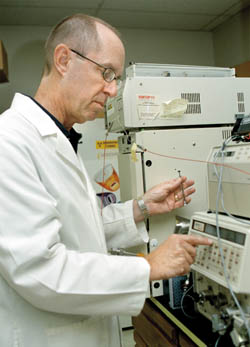
Dr. Lawrence Marnett will lead a team to study COX proteins. (photo by Dana Johnson)
Marnett nets three-year grant to study differences in COX proteins
The National Foundation for Cancer Research has awarded new research funding to support work at the Vanderbilt-Ingram Cancer Center to better understand the differences between two related proteins involved in tumor development as well as pain and inflammation.
The $300,000, three-year grant will support basic cancer research by Lawrence J. Marnett, Ph.D., in Vanderbilt-Ingram’s A.B. Hancock Memorial Research Center to identify and examine functional biochemical differences between cyclooxygenase (COX) 1 and 2. COX-2 in particular appears to play an important role in cancer development and is expressed in many human tumors including lung, colon, breast, prostate, bladder, pancreas, and esophagus.
“The National Foundation for Cancer Research provides support for innovative and high risk research that has potential for the sorts of discoveries that push science into new areas,” said Marnett, Mary Geddes Stahlman Professor of Cancer Research. Marnett is director of the Hancock center and associate director for basic science programs at the Vanderbilt-Ingram Cancer Center. “Funding for that type of work is often quite difficult to come by, so we are very appreciative of the National Foundation for Cancer Research’s support.”
The cyclooxygenases are the targets for aspirin and similar non-steroidal anti-inflammatory drugs (NSAIDs) like ibuprofen. COX-1’s job is to produce the prostaglandins that protect the stomach lining from irritation; COX-2 becomes active under specific conditions to produce prostaglandins that cause inflammation, pain and promote tumor development and growth. Because aspirin and NSAIDs target both COX-1 and COX-2, they often cause stomach irritation along with providing pain and inflammation relief.
New drugs that target only COX-2, without affecting COX-1, have recently been developed. They are initially being marketed as treatments for arthritis, but they are also being studied at Vanderbilt-Ingram for their potential to prevent cancer. Vanderbilt-Ingram scientists have uncovered evidence in the laboratory that suggests COX-2 inhibitors might be helpful in treating cancer as well. These drugs are based on minute differences in physical structure that permit fairly specific targeting of COX-2.
Marnett and his colleagues have recently discovered that endocannabinoid, 2-arachidonyl-glycerol (2-AG), is a substrate for COX-2 and is converted into a series of novel glyceryl-prostaglandins. COX-2 oxygenates natural derivatives of arachidonic acid such as esters and amides whereas COX-1 does not.
“There is little difference between COX-1 and COX-2 at the protein level,” Marnett said. “But for some reason, COX-1 is always present, while COX-2 only comes on when needed. It comes on like gangbusters, then goes away. Over the past year, we have identified a functional biochemical difference between the two proteins. If we can better understand that difference, we’re hopeful that knowledge will allow us to exploit the difference to develop even more specific and effective drugs to prevent and potentially treat cancer.”
“With NFCR’s funding support, Dr. Marnett will be able to do bold and blue-sky exploration,” said Dr. Sujuan Ba, Science Director of the National Foundation for Cancer Research. “We believe the findings from Dr. Marnett’s research will aid in the development of the next generation of cancer preventive or therapeutic agents by identifying new molecular targets for drug development.”













